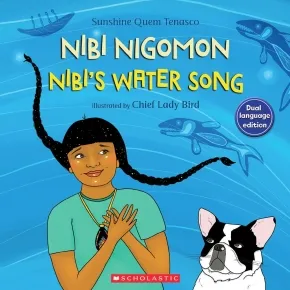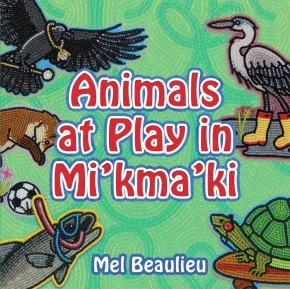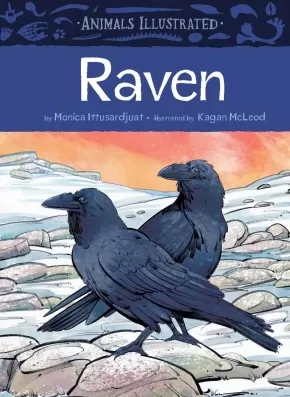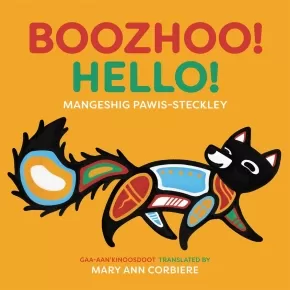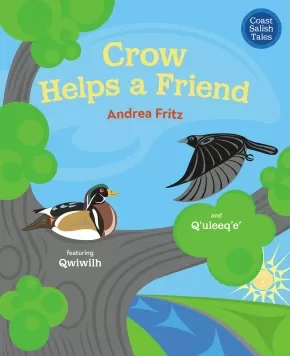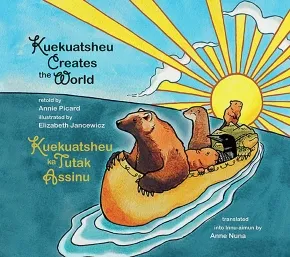
First Nation Communities Read
1
-
15
of
275 Results;
Sort By
Go To
of 19
First Nation Communities Read is an annual reading program launched in 2003 by the First Nations public library community in Ontario. First Nation Communities Read selected and other recommended titles:
- encourage family literacy, intergenerational storytelling, and intergenerational information sharing;
- are written and/or illustrated by, or otherwise involve the participation of a First Nation, Métis, or Inuit creator;
- contain First Nation, Métis, or Inuit content produced with the support of First Nation, Métis, or Inuit advisers/consultants or First Nation, Métis, or Inuit endorsement.
To view the young adult and adult selections, visit:
First Nation Communities Read - Young Adult Selections
First Nation Communities Read - Adult Selections
- encourage family literacy, intergenerational storytelling, and intergenerational information sharing;
- are written and/or illustrated by, or otherwise involve the participation of a First Nation, Métis, or Inuit creator;
- contain First Nation, Métis, or Inuit content produced with the support of First Nation, Métis, or Inuit advisers/consultants or First Nation, Métis, or Inuit endorsement.
To view the young adult and adult selections, visit:
First Nation Communities Read - Young Adult Selections
First Nation Communities Read - Adult Selections
Nibi nigomon/Nibi's Water Song
$8.99
Format:
Paperback
Text Content Territories:
Indigenous Canadian; First Nations; Anishinaabeg;
ISBN / Barcode: 9781039700673
Synopsis:
Synopsis:
Nibi is determined to bring clean water to her community.
Nibi is the Anishinabemowin word for water. In Nibi’s Water Song, Nibi is an Indigenous girl on the search for clean water to drink. Though she is faced with repeated obstacles, Nibi’s joyful and determined energy becomes a catalyst for change and action as her community rallies around her to make clean drinking water available for all.
First published in 2020, Nibi’s Water Song was shortlisted for both the IODE Jean Throop Award and longlisted for the First Nations Communities READ Award. This dual-language edition presents the text in both English and Anishinabemowin.
Educator Information
Recommended for ages 4-8.
Dual-language: English and Anishinabemowin
Translated by Tina Nottaway. Tina is an Algonquin Anicinabe Ikwe artist and translator from Rapid Lake, Quebec. She is fluent in her language, Anicinabemowin. Tina is also a crafter and facilitates workshops on moccasin making, birchbark basket making and other cultural activities.
This resource is available in English: Nibi's Water Song
This resource is also available in French: Nibi a soif, très soif
Additional Information
32 pages | 9.51" x 9.51" | Paperback
Animals at Play in Mi'kma'ki (BB)
$16.95
Format:
Board Book
Text Content Territories:
Indigenous Canadian; First Nations; Mi'kmaq (Mi'gmaq);
Grade Levels: Preschool; Kindergarten;
ISBN / Barcode: 9781459507449
Synopsis:
Synopsis:
In this fun board book for young kids, turtles skateboard, salmon snorkel, bears take photos and otters frolic with floaties!
Mi’kmaw artist Mel Beaulieu’s lively modern take on traditional beadwork brings these animals to life. Mi’kma’ki’s most iconic animals are portrayed in this colourful and whimsical book.
Mi’kmaw names (and pronunciation guides) make this a great introduction to contemporary Mi’kma’ki for very young children.
Educator Information
Recommended for ages 2 to 5.
Additional Information
6.53" x 6.53 | Board Book
Animals Illustrated: Raven
$17.95
Artists:
Format:
Hardcover
Text Content Territories:
Indigenous Canadian; Inuit;
ISBN / Barcode: 9781772275230
Synopsis:
Synopsis:
Perfect for nature-loving young readers who want to expand their knowledge of Arctic animals beyond polar bears and walruses!
Animals Illustrated mixes fun-filled animal facts suitable for the youngest of readers with intricately detailed illustrations to create a unique and beautiful collection of children’s non-fiction books about Arctic animals.
Each volume contains first-hand accounts from authors who live in the Arctic, along with interesting facts on the behaviours and biology of each animal. In this book, kids will learn what ravens eat, where they live, how they raise their babies, and other interesting facts, like the fact that ravens have one of the biggest brains of any bird and that they can use tools!
Educator & Series Information
Recommended Ages: 6-8
This book is part of the non-fiction Animals Illustrated series, which mixes fun-filled animal facts suitable for the youngest of readers with intricately detailed illustrations to create a unique and beautiful collection of children’s non-fiction books on Arctic animals. Each volume contains firsthand accounts from authors who live in the Arctic, along with interesting facts on the behaviours and biology of each animal.
Reading Levels:
Fountas & Pinnell Text Level Gradient: P
Guided Reading Level: P
This book is available in French: Corbeau.
Additional Information
28 pages | 6.50" x 9.00" | Hardcover
Bannock in a Hammock
$22.95
Artists:
Format:
Hardcover
Text Content Territories:
Indigenous Canadian; Inuit;
Grade Levels: Preschool; Kindergarten;
ISBN / Barcode: 9781772275384
Synopsis:
Synopsis:
Big or small, sweet or savoury, with stew or with sprinkles, there are tons of ways to enjoy bannock!
This rhyming book explores a favourite Inuit food, and has some fun along the way. What’s your favourite way to eat bannock?
Try it at home with the included bannock recipe!
Written by Inuk/Dene writer Masiana Kelly, this sweet and simple narrative celebrates this delicious food!
Reviews
"Masiana Kelly’s Bannock in a Hammock is a lively and engaging read-aloud that young children are sure to enjoy. Its playful rhythm and rhyme will keep listeners entertained while inspiring them to create rhymes of their own. Even children who have never tasted bannock will be eager to try it after hearing about the many delicious ways it can be enjoyed. A simple recipe at the end of the book invites families to make their own bannock at home, bringing the story to life in a fun and tasty way." - Debra H., Elementary School Teacher, Indigenous Books for Schools
Educator Information
Recommended for ages 3 to 5.
Includes a glossary of Inuktitut words at the back.
This book is included in the Indigenous Books for Schools database from the Association of Book Publishers of BC. It is recommended for K to 3 classrooms for English Language Arts and Foods.
Additional Information
28 pages | 9.00" x 9.00" | Hardcover
Blue Camas, Blue Camas (PB)
$14.95
Format:
Paperback
Text Content Territories:
Indigenous Canadian; First Nations; Salish; Coast Salish; Songhees (Lekwungen);
ISBN / Barcode: 9781772035247
Synopsis:
Synopsis:
The captivating story of how the Blue Camas, a flower that has been cultivated on Canada’s west coast since time immemorial, came to symbolize the meeting of two contrasting ways of life and the perseverance of traditional knowledge against all odds.
Blue Camas, Blue Camas tells the story of a flower that is native to the Northwest Coast of North America. For thousands of years, it has been considered a sacred and valuable plant by the Indigenous Peoples of this region, who harvested and traded Blue Camas bulbs all along the west coast. At the height of this period, meadows would come alive with the bright wildflowers, which would attract dozens of species of butterflies and birds, and entire villages would work together to harvest the plant and ensure its continued growth.
When Europeans arrived and began to colonize the land, they did not see the value of the Blue Camas plant, and in fact saw the meadows where the plant had been harvested as ideal terrain to grow their own crops. The story takes place at the point of contact between a Lkwungen community and a group of Irish settlers, who see the land in very different ways.
This beautifully illustrated picture book is an ode to a way of life that was threatened and nearly destroyed through miscommunication and colonization. It also raises awareness for food rights, biodiversity, and the preservation of ecosystems, offering children and teachers the opportunity to discuss these important themes in an open and constructive way.
Reviews
"Blue Camas, Blue Camas is a captivating story revealing the overlooked history of colonial contact and its impact on Indigenous communities. Through vivid storytelling and diverse voices, it emphasizes land stewardship, cultural heritage, and fostering empathy, making it a valuable resource for children.”—Samantha Beynon, author of Oolichan Moon
“A beautiful story and an important narrative about the timeline of colonial contact . . . I am happy to share this book with my children.”—Sen’ákw, Senaqwila Wyss, Squamish Nation ethnobotanist
“Danielle S. Marcotte offers a rich, historical perspective of the amazing Blue Camas plant through the eyes of a First Nations family and a settler family.”—Teoni Spathelfer, Heiltsuk author of the Little Wolf Series
“This beautiful story weaves together a rich and important narrative. Family, nature, and the village are all intertwined, with the camas at the centre of it all. So simple and yet so poignant and true!”—Robert "Lucky" Budd, co-author (with Roy Henry Vickers) of the Northwest Coast Legends Series and A Is for Anemone: A First West Coast Alphabet
Educator Information
Recommended for ages 4 to 8.
Additional Information
48 pages | 9.00" x 9.00" | Paperback
Boozhoo! / Hello!
$21.99
Format:
Hardcover
Text Content Territories:
Indigenous Canadian; First Nations; Anishinaabeg; Wasauksing First Nation;
ISBN / Barcode: 9781773067155
Synopsis:
Synopsis:
Hello! Who do you see and hear in the woods today? Meet a variety of woodland and water animals in this story written in Anishinaabemowin and English.
Can you see a fox digging, spot two minnows dancing or hear a swarm of bees buzzing? Boozhoo! / Hello! introduces children to familiar animals as they go about their daily activities: walking, running, swimming, climbing and finally - when the day is done - sleeping! Illustrated in a vibrant and colorful woodland style that will appeal to readers young and old alike, and accompanied by an author's note.
Awards
- 2025 PMC Indigenous Literature Award Winner
Reviews
"This book is written in both English and Anishinaabemowin. This dual-language approach helps immerse readers in the Anishinaabe culture and language, making it a valuable resource for those interested in Indigenous connections to animals and land. It serves as a gentle yet powerful reminder of the vital role that cultural heritage plays in the lives of Indigenous communities through art and language. A book that all children would enjoy!" - David D., Indigenous Educator & Administrator, Indigenous Books for Schools
Educator Information
Recommended for ages 3 to 6.
Dual-Language: Anishinaabemowin and English.
Translated by Mary Ann Corbiere.
Key Text Features: Author's note, translations, illustrations
Correlates to the Common Core State Standards in English Language Arts:
CCSS.ELA-LITERACY.RL.1.3
Describe characters, settings, and major events in a story, using key details.
CCSS.ELA-LITERACY.RL.1.7
Use illustrations and details in a story to describe its characters, setting, or events.
This book is included in the Indigenous Books for Schools database from the Association of Book Publishers of BC. It is recommended for K to 3 classrooms for Art, English Language Arts, and Social Studies.
Additional Information
32 pages | 8.75" x 8.75" | Hardcover
Crow Helps a Friend
$21.95
Artists:
Format:
Hardcover
Text Content Territories:
Indigenous Canadian; First Nations; Salish; Coast Salish; Lyackson ;
ISBN / Barcode: 9781459836242
Synopsis:
Synopsis:
Mistakes can be an opportunity for growth.
Indigenous artist and storyteller Andrea Fritz tells the tale of a wood duck and a crow who turn a mistake into an opportunity for friendship and growth.
Qwiwilh the wood duck is preparing to nest in his favorite tree when Q'uleeq'e' the crow invites him to play in the tall branches. They jump higher and higher up the tree until they accidentally break the branches and come crashing down into the stream below. After a daring rescue, Qwiwilh sadly realizes his nesting spot is gone, and Q'uleeq'e' decides to make things right for her new friend.
In this original story set in Coast Salish Traditional Territory, author and artist Andrea Fritz uses Indigenous storytelling techniques and art to share the culture and language of the Hul’q’umi’num’-speaking Peoples. This is the second book in the Coast Salish Tales, following Otter Doesn't Know.
Reviews
"Crow Helps a Friend... focuses on social-emotional learning and literacy development. In Social Studies, the book reinforces concepts of community and cooperation through Crow’s journey of helping a friend. It supports Language Arts by prompting discussions on empathy, friendship dynamics, and problem-solving strategies illustrated in the story. The narrative also enhances Personal and Social Development by encouraging students to recognize and manage emotions, fostering emotional intelligence crucial for their social interactions. This book teaches Hul'qumi'num and Coast Salish art." - David D., Indigenous Educator & Administrator, Indigenous Books for Schools
Educator & Series Information
Recommended for ages 6 to 8.
This is the second book in the Coast Salish Tales series, following Otter Doesn't Know.
Recommended in the Indigenous Books for Schools catalogue as a valuable resource for English Language Arts and Art in K to Grade 3.
Themes: Animals, Art, Community, Connectedness to Nature, Respect, Language, Relationships, Traditional Knowledge
Additional Information
32 pages | 8.75" x 10.75" | Hardcover
Dad, I Miss You
$22.95
Artists:
Format:
Hardcover
Text Content Territories:
Indigenous Canadian; Inuit;
ISBN / Barcode: 9781772274820
Synopsis:
Synopsis:
Told in the voice of a boy and his father by turns, this book takes a thoughtful and heartfelt look at the emotional toll of a child being taken from their family and community to attend residential school.
While the child’s internal monologue expresses his fear, confusion, and loss, the father’s monologue conveys his own sadness, fears, and hopes for the future of his child. The narrative gives voice to the things left unsaid between a parent and child experiencing this heart-rending separation. Upon his return to his community, when father and son are reunited, they must start the long process of reconnection.
Based on the author’s family history of residential school separation, this book provides a unique perspective on the difficult cycle of loss, reconnection, and regaining hope for the future.
Reviews
"Inuk author Nadia Sammurtok offers a moving dual narrative that explores the intergenerational impact of residential schools. Through the voices of a young boy sent away to school and his father left behind, the story reveals their shared pain and emotional disconnect. Although the two never speak to each other directly, their perspectives unfold in parallel, capturing the quiet devastation of forced separation. The father’s recurring line—“They said it will be better this way”—reflects the historical rationale used to justify residential schools, making this book a powerful tool for reflection and discussion." - Debra H., Elementary School Teacher, Indigenous Books for Schools
Educator Information
Recommended for ages 9 to 12.
This book is included in the Indigenous Books for Schools database from the Association of Book Publishers of BC. It is recommended for Grades 2 to 6 for Family Studies, Physical and Health Education, and Social Studies.
Additional Infroamtion
40 pages | 9.00" x 8.00" | Hardcover
Four Fallen Eagles
$19.99
Artists:
Format:
Hardcover
Text Content Territories:
Indigenous Canadian;
ISBN / Barcode: 9781778540431
Synopsis:
Synopsis:
Wanting to belong can be hard, and walking away can be even harder.
When a storm plucks four eaglets from their nest to the forest floor, the displaced eaglets proceed on a journey across Turtle Island to rediscover where they belong. One by one, the eaglets encounter communities of creatures who claim them. Will these lost eaglets grow the courage needed to soar in their truths?
Inspired by the Students and Communities she has worked with, Nishinaabe author Karen Whetung shares an allegory of survivance and the desire to tell our stories, share our truths, and claim our place in the world in Four Fallen Eagles.
Educator Information
Recommended for ages 7 to 10.
Additional Information
32 Pages | 9" x 9" | Hardcover
How I Survived: Four Nights on the Ice (PB)
$18.95
Artists:
Format:
Paperback
Text Content Territories:
Indigenous Canadian; Inuit;
ISBN / Barcode: 9781772274264
Synopsis:
Synopsis:
After his snowmobile breaks down halfway across the sea ice on a trip back from a fishing camp, Serapio Ittusardjuat recounts the traditional skills and knowledge he leaned on to stay alive.
This harrowing first-person account of four nights spent on the open sea ice—with few supplies and no water—shows young readers the determination and strength necessary to survive in the harsh Arctic climate, even when the worst occurs.
Awards
- 2022 Forest of Reading—Silver Birch Express Award
Reviews
"[T]he graphic novel How I Survived is a true story of Arctic survival written by Serapio Ittusardjuat, an Inuk stone carver and former mechanic.... This beautifully designed, highly engaging graphic novel should engross both reluctant readers and those seeking adventure." - Quill & Quire
Educator Information
Recommended for ages 12+
The original hardcover version was included in the Indigenous Books for Schools 2020/2021 resource list as being useful for grades 6 to 9 for English Language Arts and Social Studies.
Additional Information
48 pages | 7.25" x 9.75"
Hummingbird / Aamo-binashee
$21.95
Artists:
Format:
Hardcover
Text Content Territories:
Indigenous Canadian; First Nations; Anishinaabeg;
ISBN / Barcode: 9781459837140
Synopsis:
Synopsis:
You never walk alone.
Remember the hummingbird's teachings. Remember you are loved.
Kokum warned us to watch out for one another. If we weren't careful, Windigo would eat us. But one night, alone in the darkness, I felt its breath on my neck. Windigo's lies crept into my heart, and I believed them. When we lose connection with others, we lose ourselves, and Windigo's darkness grows and spreads.
In this deeply emotional and beautifully illustrated picture book, the ancestors send a hummingbird to a child lost in Windigo’s darkness. Its teachings of resilience, love and connection bring the child home and remind us that our ancestors are always watching and can help us find our way if we only ask.
This bilingual book includes full text in both English and Anishinaabemowin.
Educator Information
Recommended for ages 6 to 8.
Fountas & Pinnell Text Level Gradient: U
Lexile measure: 520L
Guided Reading Level: U
Dual-Language: English and Anishinaabemowin
There are many dialects fo Anishinaabemowin, and this book presents a phonetic spelling of the language as learned by the author and co-translator in Duck Bay, northeastern Manitoba. This dialect is sometimes referred to as Western Ojibwa, Nakawemowin, Saulteaux or Plains Ojibwa. Translated by Norman Chartrand and Jennifer Leason.
This beautifully illustrated story expresses hope, healing and reclamation of Indigenous strength and identity in the wake of oppression and trauma.
This book is included in the Indigenous Books for Schools database from the Association of Book Publishers of BC. It is recommended for Grades 1 to 3 for Art, English Language Arts, and Social Studies.
Additional Information
32 pages | 8.00" x 8.00" | Hardcover
I Am Metis
$23.95
Artists:
Format:
Hardcover
Text Content Territories:
Indigenous Canadian; Métis;
ISBN / Barcode: 9781554556212
Synopsis:
Synopsis:
"Who are you?", whispers the voice in the wind. "You are Métis." What does this strange word mean? A young girl watches her father to understand the unfamiliar label. Through a series of vignettes centred around her dad, the child interacts with her riverlot surroundings and delights in her Métis way of life.
Discover the joy and vibrancy of the Métis culture from a child's perspective. Feel the author's pride in her Métis identity, and her love for her father, as she relives childhood memories.
Educator Information
Recommended for ages 6 to 9.
Caution: The word "Indian" is used in this work when the author recounts a memory from her childhood.
Additional Information
32 pages | 10.00" x 8.00" | Hardcover
It Bears Repeating
$23.99
Artists:
Format:
Hardcover
Text Content Territories:
Indigenous Canadian; Inuit;
ISBN / Barcode: 9781774880555
Synopsis:
Synopsis:
This beautifully crafted picture book celebrates one of the world's most awesome animals: the polar bear. Evocative but simple text by award-winning musician and artist Tanya Tagaq is accompanied by striking art in this classic counting book.
Beginning with 1 proud polar bear standing tall and ending with 10 bears waving goodbye, this delightful counting book shows polar bears in all their forms: slippery and fast, crafty and cool, hungry and proud. Tanya has created a story meant to be read aloud, incorporating simple Inuktitut words and using her keen ear for the musical sound of language.
This book is joyful, powerful, clever and striking — much like the bears who sniff, slide, swim, hunt, play and dance through its pages. And when you get to the last page, you won't be able to resist going back to repeat the journey!
Educator Information
Recommended for ages 3 to 7.
Concepts: Counting & Numbers; Animals - Polar Bears.
This book is meant to be read aloud and incorporates simple Inuktitut words.
Additional Information
24 pages | 10.50" x 9.00"
Kaiah's Garden
$19.99
Format:
Hardcover
Text Content Territories:
Indigenous Canadian; First Nations; Cree (Nehiyawak);
ISBN / Barcode: 9781443190251
Synopsis:
Synopsis:
An uplifting story of a girl’s connection to her beloved grandmother through the beadwork art they created together.
As she wakes up one dull morning, Kaiah feels as cold and grey as the day. She longs to be with her grandmother again. Kaiah’s life doesn’t feel right without her. But through Kaiah’s treasured bead box — and the beauty it holds — she is with her grandmother, in a garden that is full of colour and love.
This beautiful story from award-winning author Melanie Florence celebrates the universal love between grandmother and child. Featuring bright, breathtaking illustrations from Tsilhqot’in and Syilx artist Karlene Harvey, the book also features back matter about the Indigenous tradition of beading.
Educator Information
Recommended for ages 3 to 8.
This book is available in French: Le jardin de Kaiah.
Additional Information
32 pages | 8.35" x 10.27" | Hardcover
Kuekuatsheu Creates the World / Kuekuatsheu ka Tutak Assinu: (Sheshatshiu dialect)
$24.99
Artists:
Format:
Hardcover
ISBN / Barcode: 9781998802203
Synopsis:
Synopsis:
The story of how the world came to be on the turtle's back can be found in Indigenous cultures throughout North America/Turtle Island. It has many variations. This moving version of the tale—a story of resilience, sacrifice, and friendship—is one that Annie Picard was often told as a child by her maternal grandmother while they lived in nutshimit (on the land) in the Labrador/Quebec peninsula. Picard's lovely re-telling of this traditional Innu story of how little muskrat makes an enormous sacrifice to help the wolverine and his other friends rebuild the world after a great flood is brought vividly to life by Elizabeth Jancewicz's stunning illustrations.
Educator Information
Recommended for ages 4 to 8.
Bilingual: English and Innu-aimun.
Translation into Innu-aimun by Anne Nuna.
Additional Information
36 Pages | 9" x 8" | Hardcover | 2nd Edition
Sort By
Go To
of 19

